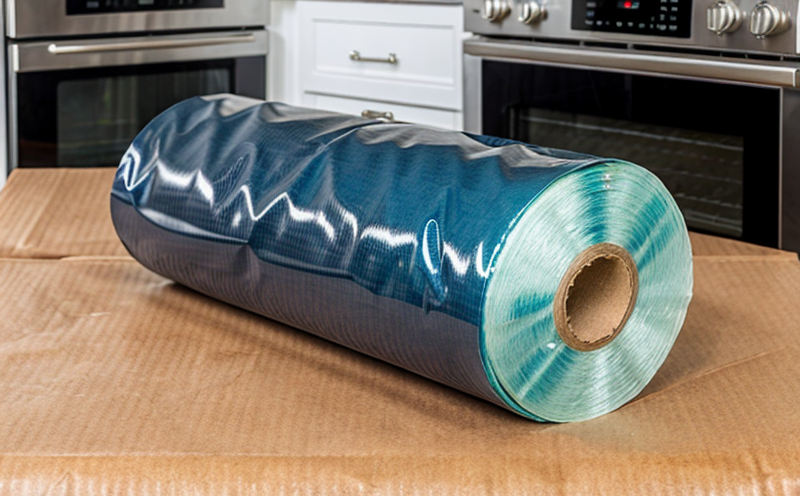UNE EN 13137 Odor Evaluation Testing of Plastic Wraps
The UNE EN 13137 standard provides a standardized methodology for the evaluation of odors released by plastic wraps and covers. This test is crucial in ensuring that packaging materials do not compromise product quality or safety through the release of volatile organic compounds (VOCs) or other undesirable emissions.
Odor issues can arise from various sources within plastic materials, including monomers, additives, processing aids, and residual solvents. These odors can be transferred to food products during storage or transportation, which could have a detrimental effect on the perceived quality of the product by consumers. By adhering to UNE EN 13137, manufacturers can ensure that their packaging materials meet stringent international standards for odor control.
The testing procedure involves placing test specimens in an environmental chamber under controlled conditions. The chamber maintains specific temperature and humidity levels that simulate real-world storage environments. Air samples are then collected from the chamber at predetermined intervals over a specified period, typically 24 hours or more depending on the material's properties.
The air samples are analyzed using gas chromatography-mass spectrometry (GC-MS), which provides detailed information about the volatile organic compounds present. Analysts identify and quantify these components to determine whether they fall within acceptable limits set by UNE EN 13137. The standard specifies maximum allowable concentrations for a range of odor-causing substances, including aldehydes, ketones, esters, and other relevant chemicals.
Manufacturers must consider the potential impact of different plastic formulations on odor release. For instance, polyethylene (PE) is commonly used in household wraps due to its excellent barrier properties and low cost. However, certain types of PE may contain additives that contribute to odor generation during storage or use. Similarly, polyvinyl chloride (PVC) and polypropylene (PP) have their own unique characteristics regarding odor emissions.
Proper specimen preparation is critical for accurate testing results. Before conducting the test, samples must be conditioned in a controlled environment to equilibrate with the specified temperature and humidity levels. This ensures that any differences observed during testing are due solely to the intrinsic properties of the plastic rather than variations in moisture content or thermal history.
The equipment used for this type of evaluation includes environmental chambers capable of maintaining precise temperature and humidity control, GC-MS instrumentation for analyzing air samples, and sampling pumps to collect representative portions of ambient air. Compliance with UNE EN 13137 not only enhances product safety but also protects brand reputation by ensuring consistent quality across batches.
Additionally, this standard helps manufacturers comply with regulatory requirements in various regions around the world where there are strict limits on emissions from packaging materials. Meeting these standards demonstrates a commitment to environmental responsibility and consumer welfare, which can lead to increased market share and customer loyalty.
Benefits
Implementing UNE EN 13137 odor evaluation testing offers numerous advantages for manufacturers of household wraps and covers. Firstly, it ensures compliance with international standards, thereby reducing the risk of non-conformance penalties or recalls. Secondly, by identifying potential odor issues early in the development process, companies can make necessary adjustments to their formulations before going to market.
Moreover, this testing enhances product safety and maintains consumer confidence. Consumers are increasingly concerned about the quality and purity of food packaging materials, especially those that come into direct contact with consumables. Eliminating odor-causing compounds from household wraps helps maintain a hygienic environment while preserving the freshness and taste of stored products.
From an operational perspective, UNE EN 13137 provides clear guidelines on how to conduct odor evaluations consistently across different facilities. This standardization reduces variability in test results and improves reproducibility between labs, leading to more reliable data for decision-making purposes.
Customer Impact and Satisfaction
Customers benefit significantly from adhering to UNE EN 13137. The primary advantage lies in enhanced product safety, as the test ensures that no harmful volatile organic compounds (VOCs) are released into packaged foods or other materials during storage or use. This contributes directly to maintaining the integrity and appeal of products, thus enhancing overall customer satisfaction.
By eliminating unpleasant odors from household wraps, consumers experience a more pleasant handling and usage process. Such improvements can translate into higher levels of customer loyalty since satisfied customers are more likely to recommend the product positively. Additionally, meeting international standards like UNE EN 13137 reflects well on brand reputation, which is essential for attracting new customers and expanding market reach.
Furthermore, companies that invest in robust quality assurance programs incorporating UNE EN 13137 odor evaluation testing demonstrate a strong commitment to sustainability. This aligns with growing consumer trends towards eco-friendly products, potentially opening up opportunities for entering niche markets focused on green initiatives.
Environmental and Sustainability Contributions
The implementation of UNE EN 13137 odor evaluation testing plays a significant role in promoting environmental sustainability. By minimizing the emission of harmful VOCs from plastic wraps, manufacturers contribute positively to air quality by reducing indoor pollutants that may affect human health.
Adherence to these standards also supports resource conservation efforts. When manufacturers identify and eliminate sources of odors early in their product lifecycle through rigorous testing procedures like those outlined in UNE EN 13137, they can optimize raw material usage efficiently without compromising performance or safety standards.
This approach fosters innovation within the industry by encouraging research into alternative formulations that not only meet odor requirements but also contribute to broader sustainability goals such as reducing waste generation and promoting recyclability. Such innovations ultimately benefit both the environment and society at large.





